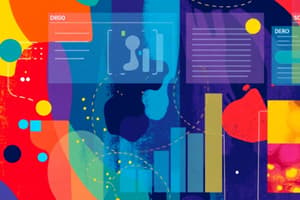Podcast
Questions and Answers
What is the primary audience for PowerBI Desktop?
What is the primary audience for PowerBI Desktop?
- Business users focused on collaboration
- Developers and Designers (correct)
- AI specialists and Data Scientists
- Casual users needing basic reporting
Which feature differentiates PowerBI Desktop from PowerBI Service?
Which feature differentiates PowerBI Desktop from PowerBI Service?
- The ability to create relationships between tables (correct)
- Cloud-based collaboration
- Real-time data updates
- License-free personal use
In what way does PowerBI differ from traditional SQL databases?
In what way does PowerBI differ from traditional SQL databases?
- It is designed for real-time data updates
- It primarily focuses on data storage capabilities
- It emphasizes analysis and visualization over data storage (correct)
- It provides built-in data storage solutions
Which AI capability does Power Apps offer to enhance the app development process?
Which AI capability does Power Apps offer to enhance the app development process?
What is the first step in building an app using Power Apps in 10 minutes?
What is the first step in building an app using Power Apps in 10 minutes?
Study Notes
Power BI as a Database Tool
- Power BI has two solutions: Desktop and Service
- Power BI Desktop:
- Installed on a computer, free license for personal use
- Creates reports and dashboards
- Uses Power Query for cleaning and transforming data from sources like Excel and SQL
- Creates relationships between tables, similar to relational databases
- Visualizes data with interactive dashboards
- Designed for developers and designers
- Power BI Service:
- Cloud-based platform for sharing and collaborating on reports
- Offers real-time data updates and sharing with team members
- Provides fewer features than Power BI Desktop; intended for business users collaborating on reports built by developers
Comparison with Traditional SQL Databases
- Power BI focuses on analysis and visualization, not data storage
- Used to explore and connect data, not a primary storage tool
Using AI in Power Apps to Create Databases and Apps
- Power Apps is a low-code platform for creating custom applications connected to databases (e.g., SQL or Excel)
- Drag-and-drop interface creation
- AI tools (e.g., Copilot) assist in generating tables, forms, and business logic
- Improves productivity and accessibility for non-technical users
Steps to Build an App in 10 Minutes
- Step 1: Generate Data: AI defines database structure (e.g., customers, rentals)
- Step 2: Create an Interface: Automatically generates forms and screens based on the database
- Step 3: Integrate Logic: Adds AI-driven functionality (e.g., automated responses, workflows)
Studying That Suits You
Use AI to generate personalized quizzes and flashcards to suit your learning preferences.


